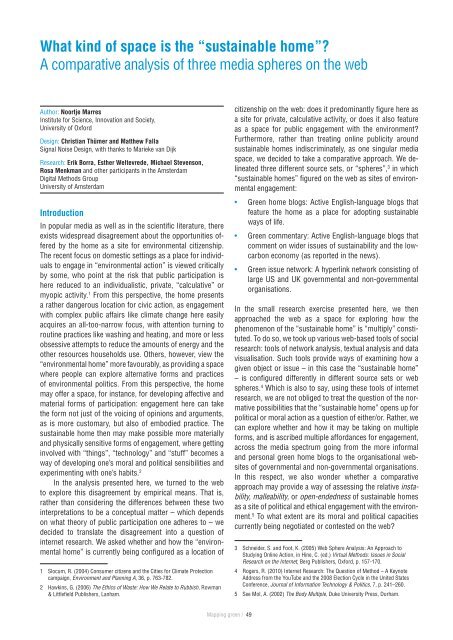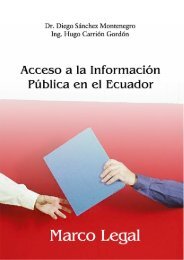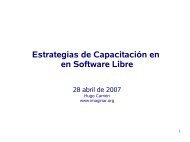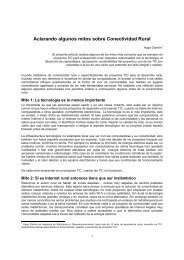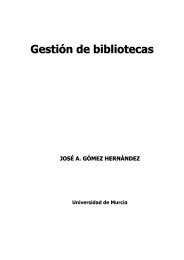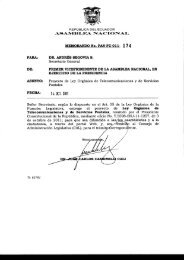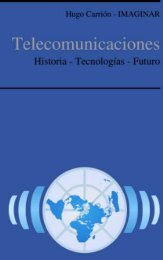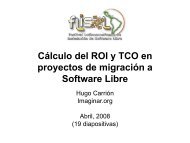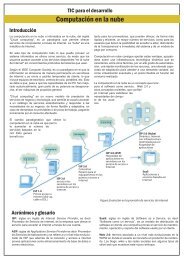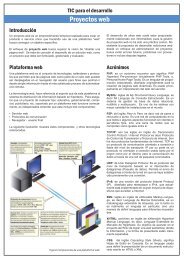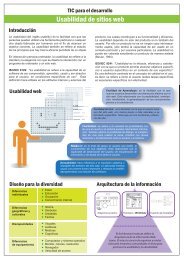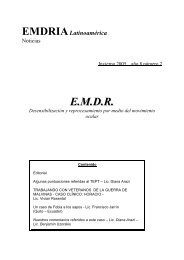GLOBAL INFORMATION SOCIETY WATCH 2010
GLOBAL INFORMATION SOCIETY WATCH 2010
GLOBAL INFORMATION SOCIETY WATCH 2010
You also want an ePaper? Increase the reach of your titles
YUMPU automatically turns print PDFs into web optimized ePapers that Google loves.
What kind of space is the “sustainable home”?<br />
A comparative analysis of three media spheres on the web<br />
Author: Noortje Marres<br />
Institute for Science, Innovation and Society,<br />
University of Oxford<br />
Design: Christian Thümer and Matthew Falla<br />
Signal Noise Design, with thanks to Marieke van Dijk<br />
Research: Erik Borra, Esther Weltevrede, Michael Stevenson,<br />
Rosa Menkman and other participants in the Amsterdam<br />
Digital Methods Group<br />
University of Amsterdam<br />
Introduction<br />
In popular media as well as in the scientific literature, there<br />
exists widespread disagreement about the opportunities offered<br />
by the home as a site for environmental citizenship.<br />
The recent focus on domestic settings as a place for individuals<br />
to engage in “environmental action” is viewed critically<br />
by some, who point at the risk that public participation is<br />
here reduced to an individualistic, private, “calculative” or<br />
myopic activity. 1 From this perspective, the home presents<br />
a rather dangerous location for civic action, as engagement<br />
with complex public affairs like climate change here easily<br />
acquires an all-too-narrow focus, with attention turning to<br />
routine practices like washing and heating, and more or less<br />
obsessive attempts to reduce the amounts of energy and the<br />
other resources households use. Others, however, view the<br />
“environmental home” more favourably, as providing a space<br />
where people can explore alternative forms and practices<br />
of environmental politics. From this perspective, the home<br />
may offer a space, for instance, for developing affective and<br />
material forms of participation: engagement here can take<br />
the form not just of the voicing of opinions and arguments,<br />
as is more customary, but also of embodied practice. The<br />
sustainable home then may make possible more materially<br />
and physically sensitive forms of engagement, where getting<br />
involved with “things”, “technology” and “stuff” becomes a<br />
way of developing one’s moral and political sensibilities and<br />
experimenting with one’s habits. 2<br />
In the analysis presented here, we turned to the web<br />
to explore this disagreement by empirical means. That is,<br />
rather than considering the differences between these two<br />
interpretations to be a conceptual matter – which depends<br />
on what theory of public participation one adheres to – we<br />
decided to translate the disagreement into a question of<br />
internet research. We asked whether and how the “environmental<br />
home” is currently being configured as a location of<br />
1 Slocum, R. (2004) Consumer citizens and the Cities for Climate Protection<br />
campaign, Environment and Planning A, 36, p. 763-782.<br />
2 Hawkins, G. (2006) The Ethics of Waste: How We Relate to Rubbish, Rowman<br />
& Littlefield Publishers, Lanham.<br />
citizenship on the web: does it predominantly figure here as<br />
a site for private, calculative activity, or does it also feature<br />
as a space for public engagement with the environment?<br />
Furthermore, rather than treating online publicity around<br />
sustainable homes indiscriminately, as one singular media<br />
space, we decided to take a comparative approach. We delineated<br />
three different source sets, or “spheres”, 3 in which<br />
“sustainable homes” figured on the web as sites of environmental<br />
engagement:<br />
• Green home blogs: Active English-language blogs that<br />
feature the home as a place for adopting sustainable<br />
ways of life.<br />
• Green commentary: Active English-language blogs that<br />
comment on wider issues of sustainability and the lowcarbon<br />
economy (as reported in the news).<br />
• Green issue network: A hyperlink network consisting of<br />
large US and UK governmental and non-governmental<br />
organisations.<br />
In the small research exercise presented here, we then<br />
approached the web as a space for exploring how the<br />
phenomenon of the “sustainable home” is “multiply” constituted.<br />
To do so, we took up various web-based tools of social<br />
research: tools of network analysis, textual analysis and data<br />
visualisation. Such tools provide ways of examining how a<br />
given object or issue – in this case the “sustainable home”<br />
– is configured differently in different source sets or web<br />
spheres. 4 Which is also to say, using these tools of internet<br />
research, we are not obliged to treat the question of the normative<br />
possibilities that the “sustainable home” opens up for<br />
political or moral action as a question of either/or. Rather, we<br />
can explore whether and how it may be taking on multiple<br />
forms, and is ascribed multiple affordances for engagement,<br />
across the media spectrum going from the more informal<br />
and personal green home blogs to the organisational websites<br />
of governmental and non-governmental organisations.<br />
In this respect, we also wonder whether a comparative<br />
approach may provide a way of assessing the relative instability,<br />
malleability, or open-endedness of sustainable homes<br />
as a site of political and ethical engagement with the environment.<br />
5 To what extent are its moral and political capacities<br />
currently being negotiated or contested on the web?<br />
3 Schneider, S. and Foot, K. (2005) Web Sphere Analysis: An Approach to<br />
Studying Online Action, in Hine, C. (ed.) Virtual Methods: Issues in Social<br />
Research on the Internet, Berg Publishers, Oxford, p. 157-170.<br />
4 Rogers, R. (<strong>2010</strong>) Internet Research: The Question of Method – A Keynote<br />
Address from the YouTube and the 2008 Election Cycle in the United States<br />
Conference, Journal of Information Technology & Politics, 7, p. 241–260.<br />
5 See Mol, A. (2002) The Body Multiple, Duke University Press, Durham.<br />
Mapping green / 49


